These animals’ ability to control light renders them almost invisible
We’ve all heard of squid and octopus using pigments to blend in with their surroundings, but what about becoming completely invisible? To become actually see through, and appear as if you aren’t there, you need to either allow light to travel through you unimpeded, or bend light around you - so that none reflects back at an observer. It’s a tricky task, but some animals are almost there.
Glass octopus
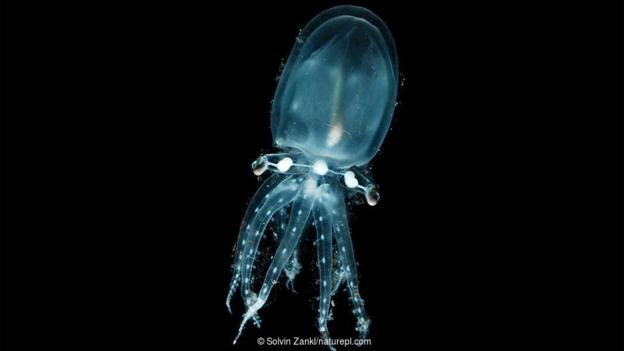
In the sea creatures have two options on the off chance that they need to stow away. Animals that live in the profound sea near the ocean bottom can mix in with sand or shakes, or stow away in coral. In the profound sea it is regularly pitch dark in any case and predators need eyes, so being undetectable isn't fundamental.
Creatures that live near the surface and need to cover up can deliver stunning showcases of light in a procedure known as bioluminescence, confounding predators beneath who think they are taking a gander at dappled daylight hitting the water's surface. Creatures that live in midwater however have neither of these choices. This area is known as the pelagic zone, and it likewise happens to be the place most imperceptible creatures live.
Perhaps the easiest way of becoming invisible is by being transparent and letting light travel completely through you. In open oceans, which lack structures to hide behind, being transparent is a great way of hiding from all viewpoints and angles. It’s so popular in fact that transparency has independently evolved multiple times in completely unrelated animals.
One such animal, the glass octopus (Vitreledonella richardi) is so named because it is almost completely transparent. The gelatinous creature can grow up to 45cm (18in), if you include the tentacles. It lives 300-1000m below the surface in tropical and subtropical waters across the world, and is almost completely invisible to predators except for its digestive system, optic nerves and eyes.Be that as it may, what's the point in making your entire body straightforward, if the eyes and guts are as yet noticeable? Far and away more terrible, these organs will cast shadows on the ocean bottom underneath, making them more unmistakable to predators. Eyes need to ingest light to work, so it isn't feasible for them to be straightforward. Guts sell out their substance, so unless a creature encourages on straightforward material, they will be unmistakable. However the octopus, and all hosts of straightforward animals put everything on the line to mask these dark organs. The glass octopus (Vitreledonella richardi) for instance has extremely stretched eyes which diminishes its fringe vision, yet limits the shadow it throws underneath - making it less inclined to be distinguished by predators chasing from beneath. There is likewise some proof that it orientates its body in such a route in order to limit its shadow.
The glass octopus is not the only transparent animal to come up with an ingenious way of disguising its eyes. Many transparent molluscs camouflage their eyes with mirrors, as mirrors in the open ocean reflect only more ocean and so are invisible.
Cranchiidae or glass squid
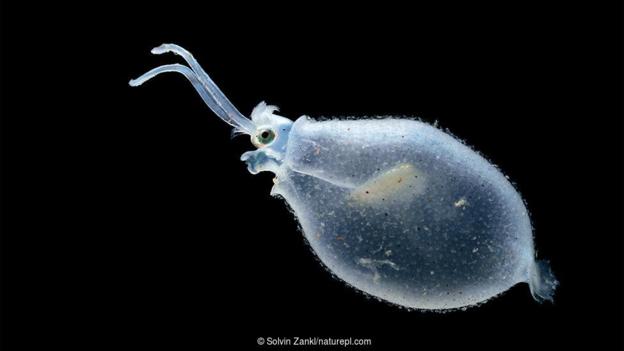
The glass group of squid, of which there are around 60 species, are completely transparent. They live, again in the pelagic district of seas around the globe, in the vicinity of 200 and 1000m beneath ocean level.
In spite of the fact that their bodies are altogether straightforward, their extensive eyes are dark, which is an issue as predators swimming underneath can without much of a stretch see the shadow they cast. However the glass squid (Cranchiidae) utilizes a smart type of disguise to conceal them. It utilizes photophores - organs underneath its eyes - to create light in a trap called counter-brightening. This light looks fundamentally the same as the daylight sifting down from above, so it makes the squid totally imperceptible to predators swimming underneath it. However the light could make the squid extremely prominent to watchers taking a gander at it from different edges. As opposed to an imperceptibility shroud, the sparkling light could act like a signal attracting predators to it.Researchers from the University of Pennsylvania found that the squid’s photophores are amazingly able to match the amount of light they produce to that coming in from every direction, creating a sort of omnidirectional invisibility cloak.
The tomopteris deep sea worm
(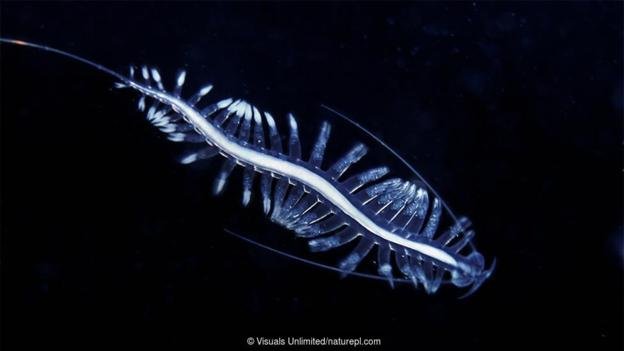 )
)
This genus, or group of marine planktonic polychaete worms are almost completely transparent, making them very difficult for predators to see. Paradoxically at least 11 species in the group can also emit bright luminous colours. Most tomopteris worms glow blue, but one species, Tomopteris nisseni can produce yellow light and is one of only few such creatures on the planet to do so.
Some tomopteris worms can even distract predators by releasing a glowing part of their body called a parapodia, making the predator chase after the dispelled body part rather than the worm itself.
Sea salp
(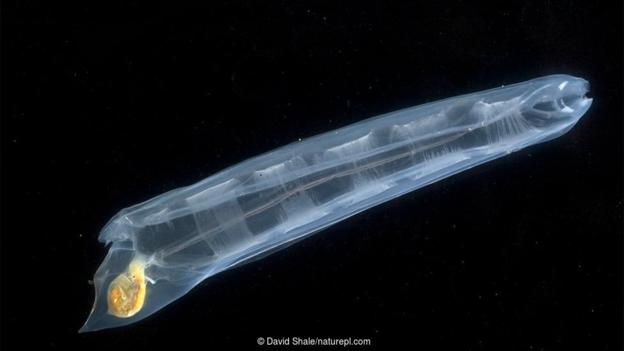 )
)
A salp is a totally straightforward barrel molded animal which swims and sustains in the meantime by drawing water through its coagulated body. They sift through the phytoplankton in the water to feast upon. In spite of the fact that they look somewhat like jellyfish they are in reality more complex and are firmly identified with fish and vertebrates - they show at least a bit of kindness and gills and can duplicate sexually.
Salps have an entrancing life cycle. For part of it they live without anyone else's input, yet they at that point clone themselves and frame long strings and different states of associated life forms. Singular salps synchronize their swimming by speaking with each other by means of electrical signs.
Hyperiids
(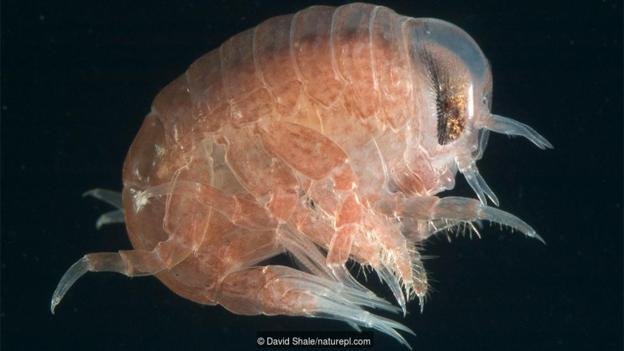 )
)
Sometimes being transparent isn’t enough, and organisms need other tricks up their sleeve to remain invisible. This is certainly the case for the Hyperiid, a little crustacean bearing a resemblance to a shrimp. They are able to hide from predators by being transparent. However that only gets them so far. A plane of glass is also transparent but you can still see it if you shine a light on it, as the light is reflected back. This is a particular problem in the ocean because many predators use bioluminescence as a searchlight when hunting for prey.A current report recommends there is a whole other world to the hyperiid's capacity to stow away than basic straightforwardness. It turns out they are utilizing a sort of nanotechnology to meddle with and twist light, shrouding themselves and practically rendering them imperceptible. The researchers utilized a filtering electron magnifying instrument to nearly dissect seven types of hyperiids. They found that the legs of one animal categories were shrouded in little nano estimated hair-like projections.
The body of this species, and six others were likewise shrouded in nano estimated knocks or circles going in measure from under 100 nanometers to around 300 nanometers. The modest size of the knocks could limit light dissipating and the researchers found that a mix of both nanostructures - the knocks and the hairs could lessen reflectance by as much as 100 overlap. The strange thing is that the analysts figure these circles could really be microscopic organisms.
Japetella heathi and Onychoteuthis banksii
The squid Japetella heathi and the octopus Onychoteuthis banksii also have a novel trick up their sleeves when it comes to invisibility - they can quickly switch from being transparent to a reddish brown colour.
They both live in the Pacific Ocean between 600-1000m deep – known as the mesopelagic zone. Although being transparent helps a lot with invisibility close to the water’s surface, as diffuse sunlight from the surface passes straight through transparent tissue, when you shine a light directly on something that is transparent, it suddenly becomes very visible.
Unfortunately this happens quite a lot in the deep sea, where predators use light-emitting organs called photophores like a searchlight when hunting. Prey at these depths are often red or black so that they reflect as little blue light as possible. Japetella heathi, an octopus, and Onychoteuthis banksii, a squid, are able to switch between both, but how do they do it? Both species’ skin contains light sensitive cells called chromatophores. The cells contain a dye, and when they detect light they immediately expand and release the pigment.
Sea Sapphires
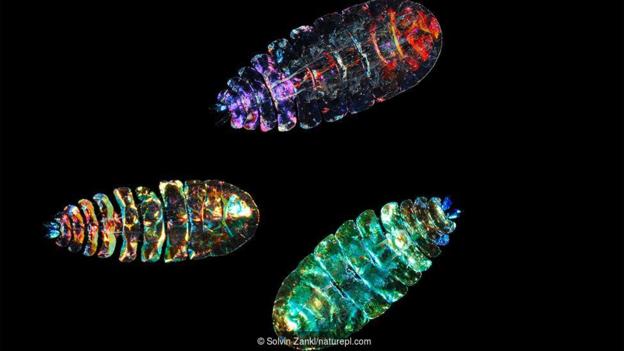
Ocean Sapphires (Sapphirina) are subterranean insect measure animals that live in warm tropical and subtropical oceans. They have a place with a gathering of shellfish called copepods. Distinctive species produce a scope of splendid radiant hues, from clear blues to reds and golds.
What is wonderful about them is that one moment they can sparkle splendidly and the following they show up practically to vanish and the way they do this is captivating. Their skin, or fingernail skin cells contain little precious stone plates orchestrated in a hexagonal honeycomb design. The gems contain guanine, one of the four bases that make up DNA. The gem layers are isolated from each other by a soup-like liquid called a cytosol.A team of scientists found that the although the layers of guanine crystals are always exactly the same thickness – 70 nanometers, the thickness of the cytosol between the layers varies from 50 to 200 nanometers. It is this variety which determines the colour of the sea sapphire. Thicker layers of cytosol lead to longer wavelengths of light being reflected, which make the copepod look red or magenta.
The colour also depends on the angle of light which strikes them. As the angle becomes smaller and smaller, the wavelength of reflected light becomes shorter and the colour more violet. If the angle becomes small enough then the reflected light is in the UV spectrum, which means that we can’t see it and the sea sapphires disappear. The researchers found that light which hit the crustaceans at a 45° angle effectively caused them to become invisible.
The glasswing butterfly
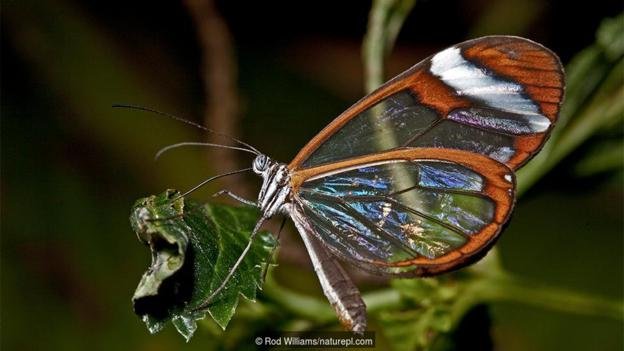
The majority of the straightforward creatures examined so far have lived in the ocean, and there's a justifiable reason explanation behind that. To be straightforward you should be comprised of stuff that neither ingests nor reflects light. This is a troublesome undertaking for plants and creatures that live ashore in light of the fact that there is such an extensive contrast between the refractive list of living tissues and air. The refractive list of a material depicts how rapidly light goes through it. Light ventures speediest in a vacuum, and as a rule the denser a material, the more extended light takes to go through it and the more prominent its refractive record will be.
As organic tissue is so substantially thicker and denser than air, when light waves go from heading out through air to body tissue, they back off. This makes light change bearings and disperse, causing reflections that make the creature more obvious.In the sea there is less difference between the refractive index of water and biological tissues, so transparency is an easier task, hence why there are so many ‘almost’ invisible animals. Another reason you don’t find many see through animals on land is because organisms need pigments like melanin to protect them from UV radiation from the sun.
However there are some exceptions to the see through rule. One is the glasswing butterfly (Greta oto) which lives in Central America.Although not all of its body is see through, its transparent wings make it difficult for predators to track it during flight. To look at how the butterfly achieves its transparency, scientists examined their wings under an electron microscope. They found tiny nano sized bumps called nanopillars which were scattered randomly and had different lengths. It seems that the random size and distribution of the nanoscale structures help the butterfly minimise reflections from its wings. The nanopillars interfere with rays of light hitting the wing, causing most to pass straight through rather than bouncing back.
@originalworks
Downvoting a post can decrease pending rewards and make it less visible. Common reasons:
Submit
The @OriginalWorks BETA V2 bot has upvoted(0.5%) and checked this post!
Some similarity seems to be present here:
http://www.bbc.com/earth/story/20170622-the-animals-that-are-almost-invisible
This is an early BETA version. If you cited this source, then ignore this message! Reply if you feel this is an error.
Downvoting a post can decrease pending rewards and make it less visible. Common reasons:
Submit